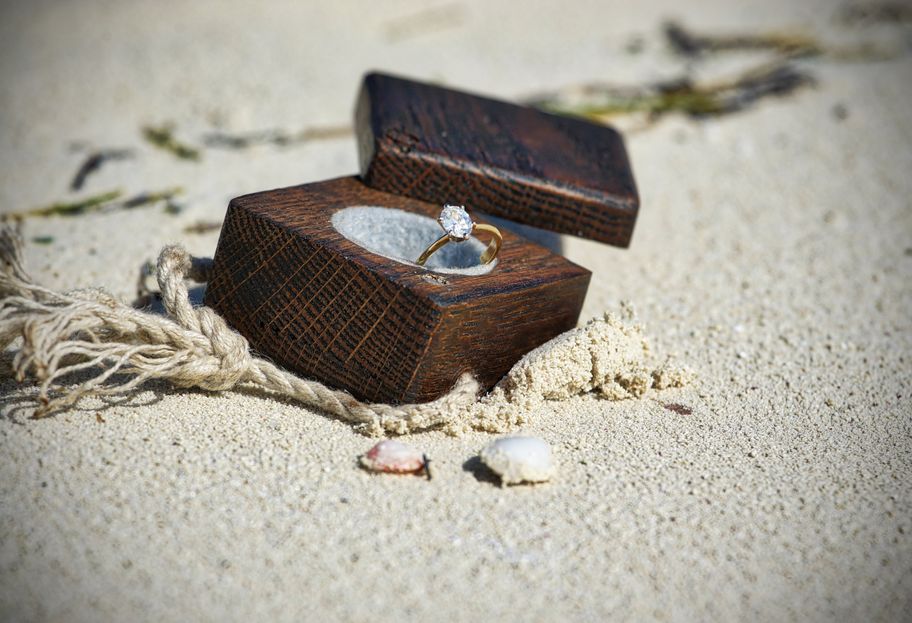You may be seeking out lab-created diamonds as an eco-friendly alternative to mined (or natural) diamonds. But as lab-created diamonds become more popular, the question is popping up more and more these days: Are lab-created diamonds really better for the environment?
Lab-created diamonds appear to be better for the environment than mined diamonds, although neither can be categorized as eco-friendly as both creation processes currently require substantial amounts of non-renewable energy and emissions to be produced or mined.
In all of my research for this article, one thing is ultra clear: We desperately need more independent, scientific research on this very nuanced topic! There is so little reliable information available at the moment, and consumers are being left to make uninformed decisions about the diamonds that they buy.
In the past, I’ve put together an article about eco-friendly diamonds and ethical issues with a table comparing lab-created and mined diamonds, and this post is sort of a continuation of my investigation!
Here I will focus on reasons why lab-created diamonds are seemingly better for the environment than mined (or natural) diamonds, although we cannot exactly call them eco-friendly based on the current research.
“On the environmental side, there is no question that synthetic diamonds will be less impactful than mined diamonds.”
Saleem H. Ali (2019), professor of energy and the environment at the University of Delaware
Lab-Created Diamonds and Environmental Impacts: What Does the Research Tell Us?
As a teacher, grad student, and person planning a wedding — research is kind of my thing! And sorting through the reliable and unreliable sources can be quite an adventure on the Internet. So, please allow me to take a stab at it!
For this post, I am drawing a lot on the 2017 research of Saleem H. Ali in the Journal of Bioeconomics, a 2011 unpublished Ali paper from the University of Vermont, and the investigative work of Rob Bates whose article was really enlightening about this issue… as I had been searching and searching, but only seemed to come up with mostly non-scientific data or not-very-substantive articles (full of “marketing lingo”) written by lab-created diamond companies.
Really digging into this issue has made me realize that I need to be much more careful as a consumer about what I fall for as “eco-friendly” and that there are consequences to every type of diamond that we choose to purchase — no source is completely without harm, unfortunately, unless we are purchasing RECYCLED diamonds (read more about this topic at the bottom of this post).
I’m aiming to be as fair and critical as possible in this post, and also to continue to educate myself as new research comes to light. In addition to environmental issues, there are so many societal and ethical issues as well. The two are inextricably linked, and therefore I speak more about the latter at the end of this post!
You may also enjoy: Are Lab-Created Diamonds Real?
Beware Diamond Companies Claiming to be Eco-Friendly, Green, or Sustainable
“Marketers should not make broad, unqualified general environmental benefit claims like ‘green’ or ‘eco-friendly.’ Broad claims are difficult to substantiate, if not impossible.”
The Federal Trade Commission’s (FTC) Green Guides
I have fallen victim many times to companies claiming to be eco-friendly or sustainable when they really aren’t And the reason for this is that there isn’t one reliable certification process or organization checking on all companies and products that claim to be eco-friendly/green/sustainable… what is a conscientious consumer to do??
Unfortunately, we’re often kind of stuck just taking the company’s word for it. And the same is true for most lab-created diamond companies. They will often claim on their websites to be “eco-friendly” or “sustainable” alternatives to mined diamonds. Even though this really isn’t true, in light of some of the data.

You may also enjoy: Why Diamond Rings are NOT Worth the Money
Lab-created diamonds may be less damaging to the environment than mined diamonds, but that doesn’t make them a green product. They do still harm the environment, as they require the use of non-renewable energy. In spite of this, the language used by many lab-created diamond companies on their websites is vague and/or suggests that they are eco-friendly.
“For all the eco-friendly claims that we see from lab-grown diamond companies, there is almost no independent research on the topic—and most growers provide little transparency as to the energy they use or growing methods.”
Rob Bates, JCK
I really do love many of these companies — I love their products, I suggest them to people who want a real diamond alternative, I love the idea of getting away from mining diamonds (even though the ethics of removing mining jobs and livelihoods does NOT make me feel good). But I don’t love being blinded and I don’t want others to be either. I just wish that companies would all advertise lab-created diamonds in a more authentic and less misleading way to their customers.
I think that many young people are tired of being “marketed” to, meaning tired of being lied to. We really just want the truth so that we can make our own choices based on the facts. If we all know the consequences of owning a real diamond (be it lab-created or mined) and we decide to buy them anyway… then that’s on us.
I have to say as well that I think we’re all a bit complicit in this situation. Lab-created diamond companies are telling us we can have real and eco-friendly diamonds, and that’s what we want to hear, and so we buy them. We buy them without really asking any questions. We’re all at fault.
“It’s striking that no conservation group has endorsed lab-grown diamonds—though plenty have endorsed electric cars. We reached out to environmental organizations on this issue. None responded.”
Rob Bates, JCK
Energy Usage
Mined diamonds require a large operation and a lot of non-renewable energy to excavate and transport.
When discussing the carbon footprint of diamond mining, Trucost said (in a JCK editorial): “Carbon emissions associated with one polished carat are six times less than those of one passenger on a one-way flight from Los Angeles to New York.” So… that doesn’t look too good for the energy required of mined diamonds.
And what about lab-created diamonds?
“Our diamond growers typically require approximately 250 kilowatt hours of electricity to grow a 1 carat diamond gemstone. That same amount of electricity would power the average US household for 9 days or allow a Tesla Model S to drive approximately 700 miles.”
Ada Diamonds
Looking at the quote from above from Ada Diamonds, a company selling lab-created diamonds, we can see that the production of lab-created diamonds requires quite a bit of energy too. So you can see right here… these things are not exactly eco-friendly. But is it as “bad” as the energy required to mine diamonds? The answers are unclear.
According to Saleem H. Ali, professor of energy and the environment at the University of Delaware, it’s really difficult to pin down the accurate numbers from companies when it comes to energy usage (for both mined and lab-created diamonds).
Ali has said that, for sure, “On the environmental side, there is no question that synthetic diamonds will be less impactful than mined diamonds.”
However, in another JCK article, Ali is quoted as writing, “Depending on the process and the location of the mine, the data can be highly divergent and cannot be used as a singular measure of environmental impact… [T]he energy usage for synthetic diamonds on a per-carat basis may still be considerably greater than for mined diamonds because of issues of scale.”
Sigh… there are no clear answers. Let’s take a look at damage to the land…
Damage to the Land and Ecosystems
This is where lab-created diamonds really seem to have the edge over mined diamonds. Excavation of diamonds from the Earth greatly impacts natural ecosystems, leaving large gaping pits and displacing animal and plant species.
There are some companies and some areas of the world that follow strict regulations for responsible mining, but this doesn’t change the fact that the environment is being altered for goods that we don’t need.
What Kind of Diamonds are Truly Better for the Environment?
The only type of real diamond that is truly better for the environment is a recycled diamond. A diamond that’s already been mined years ago, perhaps a family heirloom or a ring bought at an estate sale, is how you can obtain and wear a truly earth-friendly diamond that is also real.
Any new diamond that you purchase, be it lab-created or mined, will have had some sort of negative impact on the environment in some way, shape or form.
Lab-Created Diamonds: Environmental Issues vs. Ethical Issues
It is very important to ask ourselves as consumers: Is this good for the environment? And Is this better for the environment? But it’s also very important, in my opinion, to consider how an issue is linked to society and ethics. For instance, asking ourselves: How many jobs does this create for people?
The diamond mining industry has a bad reputation from the past. We all remember hearing about conflict diamonds and we worry that the origin of our gems may be contributing to the exploitation of workers and their families.
“With a lot of these companies there is a presumption that somehow mining is unethical. It doesn’t have to be. It has improved the lives of a lot of people who really need the money.”
Saleem H. Ali
However, according to Saleem H. Ali and others, this isn’t really the case. There are some responsible diamond mining companies whose workers rely completely on this industry, namely in poorer parts of the world.
As we potentially move more toward lab-created diamonds, we do also need to consider how this is going to affect the people who work in the diamond mining industry with little to zero other choices. And even as some of us disagree with the diamond mining industry, we can appreciate that it provides livelihoods for many people.
“This isn’t about the diamond industry being good or bad—the business has plenty of both. It’s about an undeniable fact: Millions of people and their families depend on diamond mining, and if you hurt their business you risk hurting them. The economies of poor countries are also fragile ecosystems.”
Rob Bates, JCK




